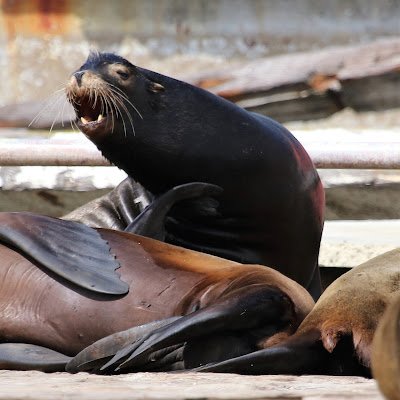Sunday 2 April 2023
 |
| Californian Sea Lion (male) - Moss Landing CA |
Moss Landing, on California's Monterey Bay, wasn't only great for birds (see previous blog post here). Draped over various jetties and pontoons in the harbour were many California Sea Lions. We had great views from our whale-watching boat (the Sea Goddess) as it cruised slowly out of Moss Landing harbour. My favourite image is of this fine male (above), identified by his larger size and peaked crown with prominent sagittal crest. Males are considerably larger than females, between three and four times the weight. But although they look big, California Sea Lions are actually the smallest of the world's sea lion species.
Sea Lions are the most easily seen of California's marine mammals, especially on San Francisco's tourist-infested Pier 39, which has a dedicated viewing area. More on that later. At Moss Landing, the Sea Lions had taken over several landing stages and pontoons in the harbour as haul-out spots. Some of the structures looked as if they were struggling to withstand the combined weight of Sea Lion blubber.
 |
| Almost full up - California Sea Lions at Moss Landing CA |
 |
| California Sea Lion at rest - Moss Landing CA |
Happily, California Sea Lions are not a threatened species, being classed as ‘least concern’ by the IUCN. Subject to hunting in the past, they are now protected by Federal law - although there is an exemption that allows them to be killed to protect certain fish stocks. Sea Lions eat a wide variety of fish species, but are themselves predated upon by Orcas and some species of shark. On land, they are also threated by Coyotes and feral dogs. California Sea Lions are found along the Pacific coast from Baja California in Mexico up to the Canadian border.
 |
| Female California Sea Lion - Moss Landing |
We also encountered Californian Sea Lions out on the ocean; the photo below of them hauled out (rather uncomfortably) on a buoy was taken from the Sea Goddess offshore from Moss Landing.
 |
| California Sea Lions on offshore buoy - Moss Landing CA |
Heading out into the ocean allowed us to watch the Sea Lions in a more natural setting, even if much less of the actual animal was visible than on the Moss Landing harbourside. Two of them were rolling around together in what looked like play, but probably wasn’t, while another appeared to be in the final stages of dismembering a decent-sized crab. I can’t be sure of the exact species of crustacean, but it looks very like a Dungeness Crab Cancer magister.
 |
| California Sea Lions offshore - Moss Landing CA |
 |
| California Sea Lion with crab - Moss Landing CA |
This is the first time that I have seen Sea Lions in the wild, and I must confess that I wasn't exactly sure how they differ from seals. The story goes like this. Taken together, seals, sea lions and the Walrus are known as pinnipeds (literally ‘fin-footed’). Ignoring the Walrus (in its own family – Odobenidae) there are two main pinniped families: Otariidae (fur seals and sea lions) and the Phocidae (true seals). So, the main zoological distinction is not between seals and sea lions, but between eared seals (including sea lions) and true seals. You can see from the harbourside photos that California Sea Lions have the little flap of skin above the ear. Of course, that poses the question: what’s the difference between sea lions and fur seals? Obviously, not a lot – as they are all in the same family, and taxonomic studies (eg Brunner, 2004 - link here) suggest that one genus of fur seal is more closely related to some sea lion species than to other fur seals. But in general terms, fur seals have more, well, fur than sea lions.
 |
| Pier 39 San Francisco CA |
We were to come across California Sea Lions again at the end of our holiday, in San Francisco Bay. Here, they are definitely the celebrities of the marine mammal world, and visitors were clearly excited about watching and photographing them. Which must be good.
 |
| California Sea Lion male - Pier 39, San Francisco CA |
 |
| A bit of aggression on the haul-out pontoons - Pier 39, San Francisco CA |
I'll end this blog post with a cheery farewell wave from one of the Pier 39 inhabitants ...
 |
References
Brunner, S. (2004) 'Fur seals and sea lions (Otariidae): identification of species and taxonomic review.' Systematics and Biodiversity, 1(3), pp.339-439.
Shirihai, H. and Jarrett, B, (2006) Whales Dolphins and Seals: A Field Guide to the Marine Mammals of the World. London: A&C Black.
Whitaker, J.O. (1980) National Audubon Society Field Guide to North American Mammals. New York: Alfred A Knopf.

No comments:
Post a Comment